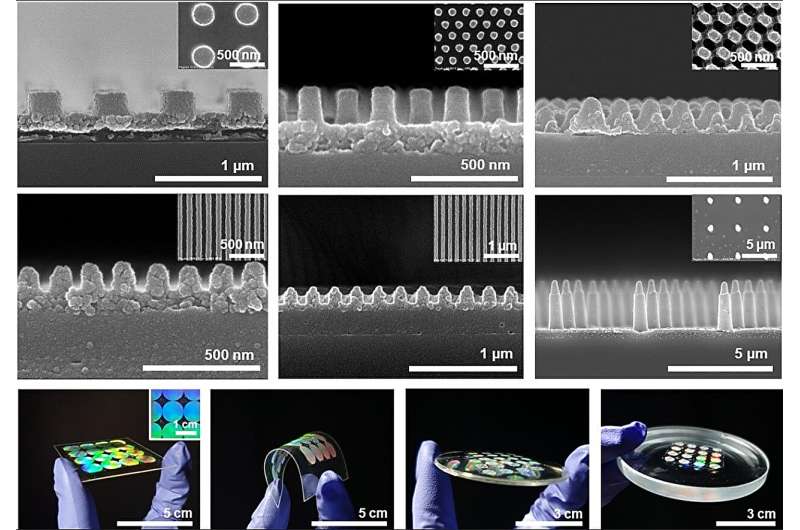This article has been reviewed according to Science X's editorial process and policies. Editors have highlighted the following attributes while ensuring the content's credibility:
fact-checked
trusted source
proofread
Advancing metasurface manufacturing with water-soluble mold

When will the protruding rear camera on smartphones become obsolete? The implementation of a metasurface, which completely disregards the properties of light, promises to reduce the thickness of a camera lens to 1/10,000 of a conventional lens. However, despite this advancement, challenges still persist due to high production costs and intricate processes. A recent study unveiled a "mold" that dissolves in water, enhancing the efficiency of the fabrication process.
A collaborative team led by Professor Junsuk Rho from the Department of Mechanical Engineering and the Department of Chemical Engineering and Joohoon Kim from the Department of Mechanical Engineering at Pohang University of Science and Technology (POSTECH), and Professor Heon Lee from the Department of Materials Science and Engineering at Korea University accomplished a feat by developing a water-soluble mold.
Through its successful application, they managed to fabricate a flawless high-resolution and high aspect ratio metasurface. These research findings have been published in Photon X.
There are two major technologies for producing metasurfaces. Electron beam lithography involves using an electron beam to draw a pattern, but it comes at a considerable cost and slow fabrication. In contrast, nanoimprint lithography employs an engraved mold to stamp the desired structure, making it a more affordable and faster method.
This approach has its own challenges, particularly with the risk of damaging the structure during the separation from the mold. The larger the structure, the higher the likelihood of damage, which poses difficulties in achieving the necessary high-resolution and high aspect ratio crucial for metasurfaces.
To address these constraints, the research team devised a water-soluble nanoimprint mold. Instead of physically separating the structure from the mold, they adopted a technique of dissolving the mold in water, thereby eliminating the risk of damaging the structure. The water-soluble mold was fabricated using polyvinyl alcohol (PVA), a flexible material that dissolves easily in water.
Furthermore, the research team conducted experiments using the water-soluble mold, achieving the successful fabrication of a metalens with a significant 1 cm area. This metalens exhibited a high-resolution and high aspect ratio of 10:1, allowing it to transcribe structures smaller than 100 nm. Notably, the mold retained its functionality within the visible regime. This novel approach offers an affordable and rapid nanoimprint process capable of achieving high-resolution and high aspect ratio results.
Professor Junsuk Rho who led the research explained, "The research represents an achievement in attaining both high-resolution and high aspect ratio through nanoimprinting using a water-soluble mold." He continued, "I hope this approach coupled with a large-area mold fabrication technology based on deep ultraviolet lithography will enable the mass production of not only lenses but various metasurfaces. Such progress would pave the way for affordable and fast manufacturing of metasurfaces."
More information: Hojung Choi et al, Realization of high aspect ratio metalenses by facile nanoimprint lithography using water-soluble stamps, PhotoniX (2023). DOI: 10.1186/s43074-023-00096-2
Provided by Pohang University of Science and Technology





















